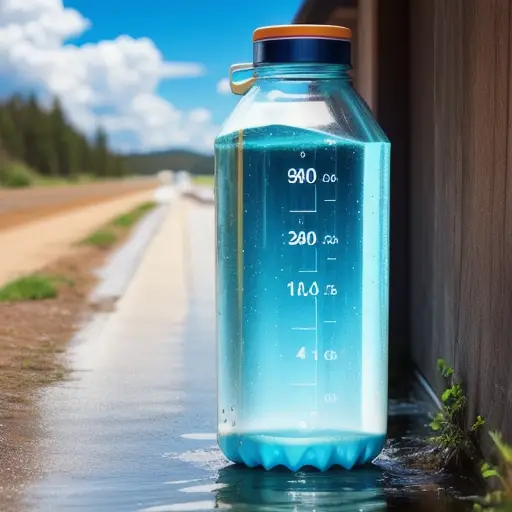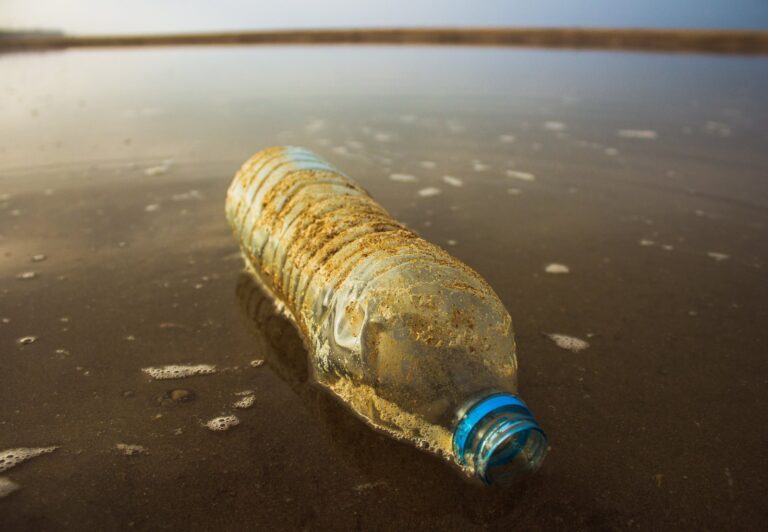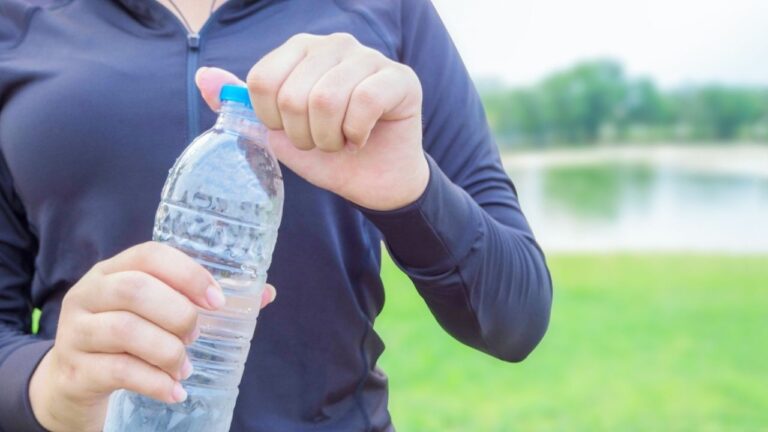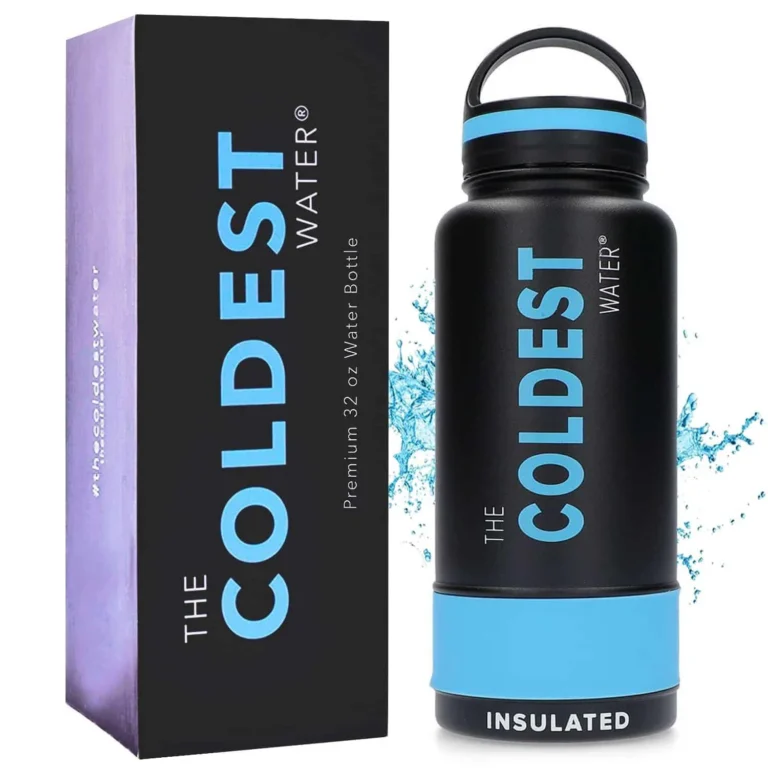Have you ever found yourself in a situation where you need to measure the amount of water you drink, but have no idea how many ounces are in your water bottle? It can be frustrating trying to accurately track your water intake when you don’t know the exact measurements. Well, the typical size of a water bottle is around 16.9 ounces.
In this blog post, we’ll explore the common sizes of water bottles and clarify how many ounces are in each one. So, whether you’re trying to stay hydrated or just curious about the size of your water bottle, keep reading to find out more!
I. Importance of water for hydration and health
Water is essential for our overall well-being and plays a vital role in keeping us hydrated and healthy. Staying hydrated is crucial for maintaining proper bodily functions, as water helps in regulating body temperature, aiding digestion, and supporting the transportation of nutrients. It also assists in getting rid of waste products and toxins through urine and sweat.
Not consuming enough water can lead to dehydration, which can cause symptoms such as dizziness, fatigue, and headaches. Chronic dehydration can even result in more serious health issues, including kidney stones and urinary tract infections.
To maintain adequate hydration levels, it’s important to drink water throughout the day. While the exact amount can vary depending on factors such as age, weight, and activity level, it is generally recommended to drink at least eight 8-ounce glasses of water per day.
So, ensuring that you have access to clean and portable water is crucial. Understanding the sizes of water bottles can be helpful in managing your hydration needs, whether you’re on the go, at work, or engaging in physical activities. Let’s explore further the various sizes of water bottles and how many ounces they typically contain.
How many ounces are in a water bottle?
How many ounces are in a water bottle? This is a common question for many people who want to stay hydrated throughout the day. The answer is not a straightforward one, as there are various sizes and types of water bottles available in the market.
The typical size of a water bottle is 16.9 ounces, which is equivalent to half a liter. However, this is just a starting point, as the sizes can vary based on the type and purpose of the bottle.
Single-serve bottles, for example, typically hold 8 to 10 ounces of water. Medium-sized bottles can range from 12 to 24 ounces, while large bottles can hold anywhere between 32 to 64 ounces. If you prefer an insulated bottle, the capacity can be anywhere between 16 to 40 ounces.
To determine the exact number of ounces in a water bottle, there are a few methods you can use. First, check for markings on the bottle which indicate the capacity. You can also use a kitchen scale to measure the weight difference before and after filling the bottle. Another option is to use a liquid measuring cup to pour water into the bottle and track the number of ounces. Finally, you can estimate the number of ounces using the bottle size as a reference.
II. Understanding Water Bottle Sizes
A. Typical size of a water bottle: 16.9 ounces
Water is an essential component of our daily lives, crucial for hydration and maintaining good health. When it comes to quenching our thirst, water bottles are a convenient and popular choice. But have you ever wondered just how many ounces are in a water bottle?
Well, the typical size of a water bottle is around 16.9 ounces. This size has become quite standard in recent years, making it easy to gauge how much water you’re consuming. However, it’s important to note that the size of a water bottle can vary based on its type and purpose.
For instance, single-serve bottles usually range from 8 to 10 ounces, making them perfect for on-the-go hydration. Medium-sized bottles typically hold between 12 to 24 ounces, striking a balance between portability and capacity. If you’re looking for a more substantial water source, large bottles ranging from 32 to 64 ounces have got you covered. Additionally, insulated bottles can hold anywhere from 16 to 40 ounces, keeping your water cool for longer.
Now that you know the various sizes water bottles come in, how can you determine the exact number of ounces in a specific bottle? Well, there are a few methods you can try. Firstly, look for markings on the bottle itself that indicate the volume. Alternatively, you can use a kitchen scale to measure the difference in weight before and after filling the bottle. Another option is to use a liquid measuring cup, pouring the water from the bottle and tracking the ounces. Lastly, you can estimate the volume using the bottle size as a reference.
To summarize, the typical size of a water bottle is 16.9 ounces, but there is a wide range of sizes available depending on your needs. To determine the exact ounces in a water bottle, you can rely on markings, a kitchen scale, a liquid measuring cup, or estimations based on the bottle size. Stay hydrated, stay healthy!
B. Variation in sizes based on type and purpose of bottle
When it comes to water bottles, there is a wide range of sizes available to suit different purposes and preferences. The size of a water bottle can vary based on its type and purpose. For single-serve bottles, which are commonly used for convenience, you can expect a capacity of about 8 to 10 ounces. Medium-sized bottles, often used for workouts or outdoor activities, can hold anywhere from 12 to 24 ounces of water. Larger bottles, usually used for longer trips or keeping hydrated throughout the day, can range from 32 to 64 ounces. If you’re looking for insulation to keep your water cold, insulated bottles typically have a capacity of 16 to 40 ounces. So, depending on your needs, there is a water bottle size out there to keep you hydrated no matter where you are.
1. Single-serve bottles: 8 to 10 ounces (8 -10 oz)
Single-serve water bottles are a popular choice for those on the go or looking for a quick and convenient way to stay hydrated. These bottles typically range in size from 8 to 10 ounces, providing just the right amount of water for a refreshing pick-me-up. With their smaller capacity, single-serve bottles are easy to carry and fit perfectly in cup holders, backpacks, or gym bags. They are ideal for short outings or when you need a quick burst of hydration during a workout. Plus, the compact size makes them a great option for kids or individuals watching their water intake. So, whether you’re grabbing a bottle before heading out for a jog or tossing one in your work bag for an afternoon recharge, single-serve bottles provide the perfect amount of water to keep you hydrated throughout your day.
2. Medium-sized bottles: 12 to 24 ounces (12 -24 oz)
Medium-sized water bottles typically range from 12 to 24 ounces in capacity. These bottles are popular for various reasons, including their versatility and portability. They are convenient to carry around, fitting easily in backpacks, gym bags, or even cup holders in cars. With a capacity of 12 to 24 ounces, they provide enough hydration for shorter periods, making them suitable for a quick trip to the gym or a short hike. Additionally, they are often designed to be reusable, reducing the need for single-use plastic bottles and helping to protect our environment. Some medium-sized water bottles also come with additional features such as built-in filters to ensure clean drinking water. So, whether you’re heading to the office, the gym, or out for a walk, a medium-sized water bottle can be a reliable companion to keep you hydrated throughout the day.
3. Large bottles: 32 to 64 ounces (32 -64 oz)
Large water bottles can be a convenient option for those who are always on the go or want to stay hydrated throughout the day without constantly refilling. These bottles typically range from 32 to 64 ounces, providing ample water to meet your hydration needs. One popular option is the 32-ounce water bottle, which offers a generous amount of water while still being compact enough to fit in most cup holders or backpack pockets. For those who require even more hydration, there are larger options available, such as 40 or 64 ounces. These bottles often come with features like a handle or a flip-top lid for easy carrying and drinking. Whether you’re heading to the gym, office, or on a hike, having a large water bottle ensures that you’ll have enough water to keep you refreshed throughout the day.
4. Insulated bottles: 16 to 40 ounces (16 -40 oz)
Insulated water bottles have gained popularity in recent years due to their ability to keep drinks hot or cold for extended periods. These bottles are designed with double walls and a layer of insulation in between, which helps maintain the temperature of the liquid inside. When it comes to size, insulated bottles generally range from 16 to 40 ounces, offering a generous capacity for your preferred beverage. The smaller sizes, like 16 or 20 ounces, are great for on-the-go use, fitting nicely in cup holders and backpack pockets. Meanwhile, the larger options, such as 32 or 40 ounces, are ideal for longer outings or situations where you don’t have easy access to refill stations. Whether you need your water ice-cold on a hot summer day or a steaming cup of tea to warm you up in winter, insulated water bottles provide a convenient and versatile solution for your hydration needs.
III. Methods to Measure Ounces in a Water Bottle
A. Check for markings on the bottle
One of the easiest ways to determine the number of ounces in a water bottle is to check for markings on the bottle itself. Many bottles will have measurements labeled directly on the side, indicating the number of ounces contained within. These markings can be a handy guide when you need to measure out a specific amount of water. However, not all bottles have these markings, especially if they are more generic or meant for single-use purposes. In such cases, there are a few other methods you can try. You can use a kitchen scale to measure the weight difference before and after adding water to the bottle. This will give you an accurate idea of the number of ounces. Alternatively, you can use a liquid measuring cup to pour water into the bottle and track the volume in ounces. Finally, if all else fails, you can estimate the number of ounces based on the bottle’s size as a reference.
B. Use a kitchen scale to measure weight difference
One of the simplest and most accurate ways to determine the number of ounces in a water bottle is by using a kitchen scale to measure the weight difference. This idea may sound unconventional, but it is actually quite effective. Start by placing an empty container on the kitchen scale and note down the weight. Then, fill the container with water until it reaches the desired level. Once again, take note of the weight. By subtracting the weight of the empty container from the weight of the container filled with water, you can easily determine the weight of the water. Since 1 fluid ounce of water weighs approximately 1 ounce, this method allows you to accurately measure the number of ounces in the water bottle. So next time you’re wondering about the exact ounces in your water bottle, simply reach for your kitchen scale and let it do the talking!
C. Use a liquid measuring cup to pour water and track ounces
One way to determine the ounces in a water bottle is by using a liquid measuring cup. This method allows you to pour water from the bottle into the cup and track the ounces accurately. To do this, simply place the measuring cup on a flat surface and make sure it is clean and dry. Then, carefully pour the water from the bottle into the cup, making sure to fill it up to the desired level. Look at the markings on the cup to determine the number of ounces. This method is especially useful if the water bottle doesn’t have clear markings indicating the ounces. It provides a reliable and precise measurement, ensuring you know exactly how much water you’re consuming. So, next time you’re unsure about the number of ounces in a water bottle, grab a liquid measuring cup and put your mind at ease.
D. Estimate using bottle size as a reference
When trying to determine how many ounces are in a water bottle, one simple method is to estimate using the bottle size as a reference. This is especially useful when you don’t have any markings or labels on the bottle indicating its capacity. By familiarizing yourself with common water bottle sizes and their corresponding capacities in ounces, you can make an educated guess.
For example, an 8-ounce water bottle is typically considered a single-serve size, while a 16-ounce bottle is a popular choice for quick refreshment. If you have a slightly larger bottle, around 24 ounces, it’s likely a medium-sized option. And if you come across a bottle that seems extra large, ranging from 32 to 64 ounces, it would fall into the category of large bottles.
Of course, these are just general guidelines, and variations can exist based on the type and purpose of the bottle. Insulated bottles, for instance, typically range from 16 to 40 ounces. By using your knowledge of common sizes, you can have a good estimate of the number of ounces in a water bottle, even without precise markings or measurements.
V. Common Water Bottle Sizes and Capacities
A. Overview of common water bottle sizes and their corresponding capacities in ounces
When it comes to staying hydrated, it’s important to have the right amount of water throughout the day. But have you ever wondered how many ounces are in a water bottle? Let’s explore the typical sizes of water bottles and their corresponding capacities.
The most common water bottle size you’ll come across is 16.9 ounces. This is often seen in standard disposable water bottles. However, the sizes can vary depending on the type and purpose of the bottle.
Single-serve bottles, for example, typically hold 8 to 10 ounces of water, making them perfect for on-the-go hydration. Medium-sized bottles range from 12 to 24 ounces, catering to those who need a bit more hydration. Large bottles, on the other hand, can hold anywhere from 32 to 64 ounces of water, suitable for those with higher water intake needs.
If you’re using an insulated bottle, the capacity can range from 16 to 40 ounces, allowing your water to stay cold or hot for longer periods.
To determine the exact ounces in a water bottle, there are a few tricks you can use. Check for markings on the bottle itself, as they often indicate the capacity. Alternatively, you can use a kitchen scale to measure any weight difference when the bottle is full and empty. Using a liquid measuring cup can also help you pour water and track the ounces accurately. And if all else fails, you can estimate based on the bottle size as a reference.
In conclusion, understanding the ounces in a water bottle is crucial for maintaining your daily hydration needs. Whether it’s a single-serve or an insulated bottle, knowing the capacity will ensure you stay properly hydrated throughout the day.
B. Examples: 8 oz, 16 oz, 24 oz, 32 oz
Water bottles come in various sizes, each serving a specific purpose. Let’s take a look at some common examples. First, we have the compact 8-ounce water bottle, perfect for short trips or quick hydration on the go. Next up is the popular 16-ounce size, often seen in gyms or during outdoor activities. This size strikes a great balance between portability and capacity. Moving on, we have the larger 24-ounce water bottle, ideal for those who prefer fewer refills and more hydration during workouts. Lastly, we have the 32-ounce water bottle, which offers a generous amount of water for intense physical activities or all-day use. These examples demonstrate the versatility of water bottle sizes and cater to the diverse needs of individuals. By understanding the available options, you can make informed choices to meet your hydration requirements.
VI. Calculating Ounces in a Water Bottle
A. How to determine the exact ounces in a water bottle
Determining the exact number of ounces in a water bottle may seem like a trivial matter, but it can be useful knowledge, especially if you’re trying to keep track of your daily water intake. Luckily, there are a few ways to figure it out. First, you can check for markings on the bottle. Many water bottles have measurements printed on the side, indicating the number of ounces. If there are no markings, you can use a kitchen scale to measure the weight difference before and after filling the bottle with water. This method allows you to calculate the exact number of ounces. Alternatively, you can use a liquid measuring cup to pour water from the bottle and track the number of ounces. Lastly, if you know the size of the water bottle, you can estimate the number of ounces based on common sizes. Overall, there are several methods you can employ to determine the exact ounces in a water bottle.
B. Using label information, bottle dimensions, or liquid weight
Determining the exact number of ounces in a water bottle can be achieved through various methods. One way is by using label information, where manufacturers often specify the capacity of the bottle in ounces. This can usually be found on the label or packaging. Another method is by referring to the bottle’s dimensions. By measuring the height and diameter of the bottle, you can use a mathematical formula to calculate its capacity in ounces. Lastly, you can determine the number of ounces by measuring the weight of the liquid inside the bottle. Using a kitchen scale, subtract the weight of the empty bottle from the weight of the bottle filled with water. The resulting difference will give you the number of ounces. By employing these methods, you can easily determine the exact ounces in a water bottle and ensure you stay properly hydrated throughout the day.
VIII. Conclusion
In summary, the importance of water for hydration and health cannot be emphasized enough. Water is essential for our bodies to function properly and can help with digestion, circulation, temperature regulation, and overall well-being. When it comes to the question of how many ounces are in a water bottle, the answer can vary based on the type and purpose of the bottle. The typical size of a water bottle is 16.9 ounces, but there are different variations available. Single-serve bottles usually range from 8 to 10 ounces, while medium-sized bottles can hold anywhere from 12 to 24 ounces. For those needing larger quantities, there are bottles available in sizes ranging from 32 to 64 ounces. Insulated bottles offer a capacity of around 16 to 40 ounces. To determine the exact ounces in a water bottle, you can check for markings on the bottle, use a kitchen scale to measure the weight difference, employ a liquid measuring cup, or simply estimate using the bottle size as a reference.




